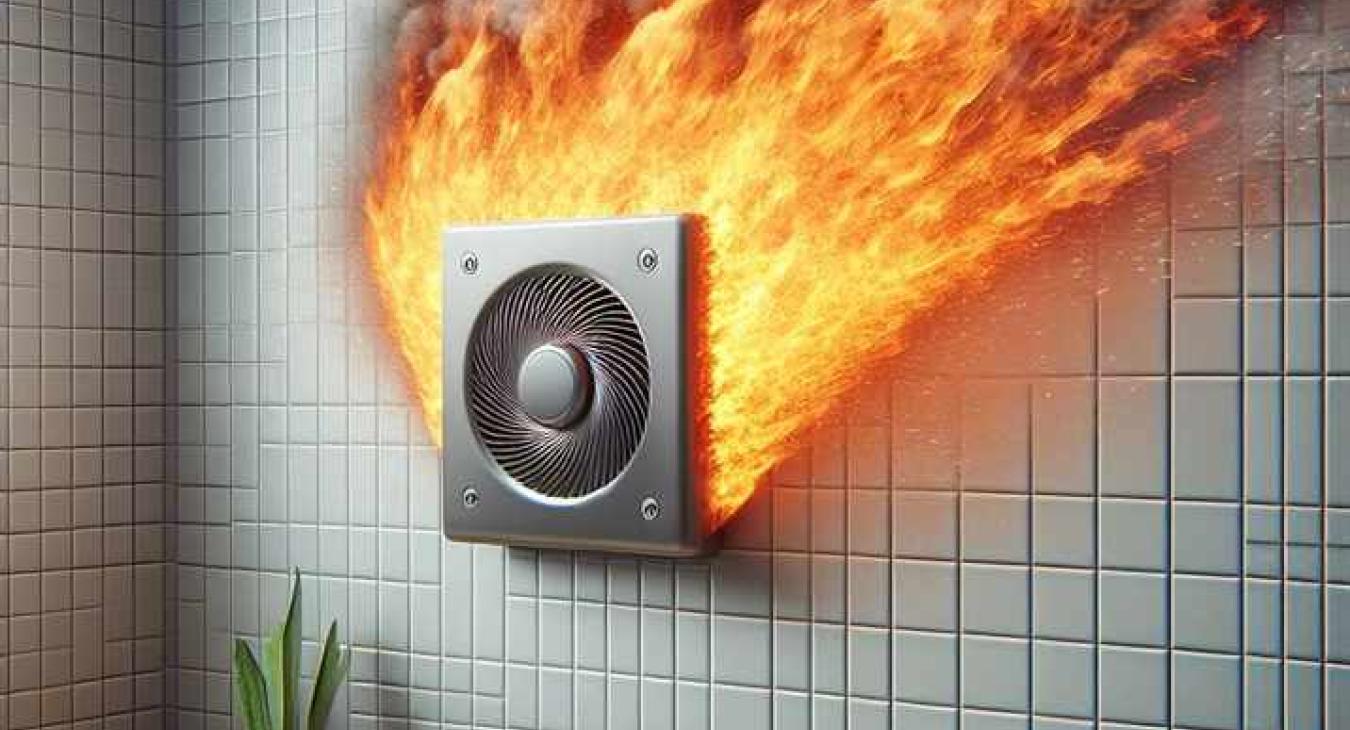First question: What do you mean by "why is my extractor fan is not working?"
We post this question because we're expecting one of two answers, and we'll help to answer both. First the first answer is "my extractor fan is literally not working, it's as dead as a doornail". The second answer is "well, my extractor an does work, but it is ineffective, and not getting rid of as much moisture as we'd like".
Scenario 1: The Completely Silent Fan
If your extractor fan is truly dead in the water (or rather, dead in the air!) and not working at all, here are some common culprits:
Power Supply Issues:
common tell-tales... Your extractor fan was working perfectly fine without a bump, and then, suddenly, it's not! You may also notice, leading up to the final day, that the fan spins up, then spins down in a cycle, or you may have heard some staticky arcing noises.
- Check if the isolator is on, the switch is turned on and the fan is plugged in properly.
- Look for a tripped circuit breaker or blown fuse. Reset the breaker or replace the fuse if necessary (but always turn off the power first!)
- If you have a timer switch, ensure it's set to run for a sufficient duration after you leave the bathroom.
- If you have a transformer, it may be getting on. Is it starting to brown / have a burning smell? In this case the transformer may need replacing
Motor Problems / blocked fan:
common tell-tales... Your extractor fan is caked in dust internally, has potentially been making a noise / been louder than usual for quite some time, and now either doesn't want to go, or is humming with no movement.
- Attempt to remove the dust (disclaimer, this should be done by a competent person, always ensure the power is isolated).
- Try to spin the fan yourself (disclaimer, this should be done by a competent person, always ensure the power is isolated).
- The motor may have overheated, does it have a burning smell? In this case the extractor fan may need replacing.
Scenario 2: The Ineffective Fan
Sometimes, the extractor fan whirls to life, but the moisture seems to linger. This could be due to several reasons:
- Insufficient Ventilation: Is your fan powerful enough for the size of your bathroom? Small fans might struggle in larger spaces, which is why we always try to use an in-line fan in the loft where we can. In fact, we find that most of the fans we come across are not powerful enough for the job, and so does building control!
- Blocked Ducts: Dust, grime, and even cobwebs can build up in the ventilation ducts, hindering airflow. Regular cleaning is essential. Dust loves getting damp and then clinging to the surfaces of fans and ducting. Candles and lit scent sticks tend to make this worse!
- Leaking Seals: Poor seals around the fan or duct openings can allow moist air to escape back into the bathroom, or worse, into the loft where you can't see it! Check for gaps and reseal where necessary.
- Insufficient Airflow Path: Is there a clear path for the extracted air to reach outside? Is there a clear path for air to flow into the bathroom to replace said extracted air? Blocked vents or closed windows can impede proper ventilation. Poorly installed ducting can reduce airflow rates drastically, as does having a bathroom door which doesn't have a 25-45mm gap, as per the latest building control guidelines.
Troubleshooting Tips:
- Listen: Does the extractor fan make any unusual noises when you turn it on? A grinding or clicking sound might indicate a failing motor.
- Feel: Can you feel air being drawn towards the fan? This is a good indicator of airflow, even if the fan seems quiet. Can it hold up a piece of toilet paper?
- Inspect: Visually check the fan for any obvious damage. You can also detach the grill and clean dust and debris from the fan blades (disclaimer, this should be done by a competent person, always ensure the power is isolated).
Solutions:
Based on your diagnosis, you can attempt some DIY fixes like cleaning the fan and ducts, replacing fuses, or resetting circuit breakers. However, for electrical work or more complex issues, it's always recommended to consult a qualified electrician to ensure your safety and professional repairs.
Maintaining Peak Performance:
Prevent future problems with regular cleaning and maintenance. Regularly vacuum the fan grill and surrounding areas. Deep clean the ducts periodically according to the manufacturer's instructions. Leaving your bathroom door ajar after showering allows for additional ventilation to help remove lingering moisture. Avoiding using candles in the bathroom will also help.
Diagnosing extractor fan symptoms, faults and issues...
You may be experiencing some of the following problems with your bathroom extractor fan, too. Let's take a look at some of the most common problems we come across when we're working on bathroom extractor fans.
Unveiling the Sounds of Trouble: Common noises bathroom extractor fans may exhibit
- Clicking: A clicking sound can indicate loose parts within the fan, the fan blades may be colliding with dust or debris inside the fan chamber, or it could be inside the motor housing, perhaps indicating a failing motor. If the clicking persists, consider seeking professional help for repairs or replacement.
- Grinding: This harsh sound often points to worn-out bearings or objects obstructing the fan blades. Turn off the fan immediately and remove any debris. If the grinding continues, a replacement motor might be necessary.
- Humming: A constant, low hum usually signifies the fan is operational but struggling. This could be due to blocked ducts, insufficient ventilation for the bathroom size (more predominant in new builds), the fan is clogged with dust inside the housing and is struggling to spin freely, or a failing motor nearing its end.
Beyond the Sounds: Other signs of Distress a bathroom extractor fan may face
- Getting Warm: A warm fan is normal during operation, but excessive heat can indicate motor strain. Check for blocked ducts, blocked fan housing, or a faulty motor that needs attention.
- Going Brown: Discoloration on the fan unit, especially orange-browning, suggests overheating which can be a fire hazard. This can appear on the corner of the fan unit rather than on the motor housing in the centre. Shut off the fan and consult a qualified electrician to investigate further.
- Water Coming In, and orange water stains: This is a serious issue! Water entering the fan unit poses an electrical safety risk. Immediately turn off the power and call an electrician to prevent damage and ensure your safety. Water stains around the fan are also a telltale sign of moisture intrusion that needs addressing. Water intrusion from a wall mounted fan is likely from a damaged external wall vent cover. Water ingress from a ceiling extractor fan is likely from conensation in the pipework which is rolling back down through the ceiling, and could be caused from improper ducting design and installation.
Light Show Mishaps:
- Light Flickering: When the fan is on, a flickering light might indicate a loose connection within the fan unit itself, a faulty switch, or even problems with the house wiring. It's best to consult an electrician to diagnose the cause for a safe and lasting solution. Other less common, more technical problems:- if it's just been wired in and has done it from the start, the light and fan could be wired in series, or the bathroom extractor fan or its humidity sensor or driver is backfeeding into the circuit.
The Noise Factor: When Silence Isn't Golden
Extractor Fan is getting Noisy: An excessively noisy fan can be a nuisance and might indicate several issues. Check for loose parts, blocked fan housing and ducts, or a failing motor causing the loud operation.
Bathroom Fan Light Not Working:
This could be due to a burnt-out bulb, a faulty switch within the fan unit, or a problem with the electrical wiring. Here's what you can do:
- Check the Bulb: Replace the bulb with a compatible one. Use the recommended wattage to avoid overheating.
- Inspect the Switch: If the bulb is fine, ensure the switch is functioning properly. A qualified electrician can diagnose and fix any switch issues.
Remember:
When dealing with electrical work, safety comes first. Maintenance on any electrical equipment should be conducted by a suitably competent person. If you require assistance, always contact an NICEIC registered electrical contractor, such as ourselves at Techmeisters Ltd
Keeping Your Extractor Fan Healthy:
- Regular Cleaning: Regularly clean the fan grill, fan housing, and ducts to prevent dust buildup that can hinder airflow and strain the motor.
- Proper Ventilation: Ensure proper ventilation by opening a window, leaving the door ajar, or ensuring there's a gap between the bottom of the door and the flooring, when using the extractor fan. This allows for efficient moisture removal. and good air volume replacement.
- Routine Maintenance: Consult your fan's manual for specific maintenance recommendations. This might include lubricating bearings or cleaning specific components at particular intervals.
By understanding the various signs and sounds of a struggling extractor fan, you can help to monitor and maintain your electrical equipment and ensure your bathroom stays fresh and free from moisture buildup. Remember, for complex issues or electrical work, a qualified electrician is your best bet for a safe and lasting solution.
Want to find out more about extractor fans and the extractor fan installation and replacement services we provide? Take a look at our extractor fan installation blog here.












